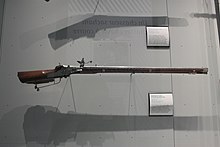
Back Arkebuse ALS قربينة Arabic Arcabuz AST Аркебуза Byelorussian Аркебуз Bulgarian আরকেবুসে Bengali/Bangla Akebut Breton Arcabús Catalan Arkebuza Czech Arkebuse Danish

An arquebus (/ˈɑːrk(w)ɪbəs/ AR-k(w)ib-əs) is a form of long gun that appeared in Europe and the Ottoman Empire during the 15th century. An infantryman armed with an arquebus is called an arquebusier.
The term arquebus is derived from the Dutch word Haakbus ("hook gun").[1] The term arquebus was applied to many different forms of firearms from the 15th to 17th centuries, but it originally referred to "a hand-gun with a hook-like projection or lug on its under surface, useful for steadying it against battlements or other objects when firing".[2] These "hook guns" were in their earliest forms of defensive weapons mounted on German city walls in the early 15th century.[3] The addition of a shoulder stock, priming pan,[4] and matchlock mechanism in the late 15th century turned the arquebus into a handheld firearm and also the first firearm equipped with a trigger.
The exact dating of the matchlock's appearance is disputed. It could have appeared in the Ottoman Empire as early as 1465 and in Europe a little before 1475.[5] The heavy arquebus, which was then called a musket, was developed to better penetrate plate armor and appeared in Europe around 1521.[6] Heavy arquebuses mounted on war wagons were called arquebus à croc.[7] These carried a lead ball of about 100 grams (3.5 oz).[8]
A standardized arquebus, the caliver, was introduced in the latter half of the 16th century. The name "caliver" is an English derivation from the French calibre – a reference to the gun's standardized bore.[9] The caliver allowed troops to load bullets faster since they fit their guns more easily, whereas before soldiers often had to modify their bullets into suitable fits, or even made their own prior to battle.
The matchlock arquebus is considered the forerunner to the flintlock musket.
- ^ Friedrich Kluge, Elmar Seebold (Hrsg.): Etymologisches Wörterbuch der deutschen Sprache. 23. Aufl., de Gruyter: Berlin/New York 1999, pp. 52.
- ^ Needham 1986, p. 426.
- ^ Chase 2003, p. 61.
- ^ Cite error: The named reference
:03was invoked but never defined (see the help page). - ^ Needham 1986, p. 443.
- ^ "Smoothbore Musketry - ScotWars". Archived from the original on 27 October 2012. Retrieved 11 February 2013. Smoothbore Musketry
- ^ Chisholm, Hugh, ed. (1911). . Encyclopædia Britannica. Vol. 2 (11th ed.). Cambridge University Press. pp. 641–642.
- ^
 This article incorporates text from a publication now in the public domain: Chambers, Ephraim, ed. (1728). "ARQUEBUSS". Cyclopædia, or an Universal Dictionary of Arts and Sciences (1st ed.). James and John Knapton, et al. p. 342.
This article incorporates text from a publication now in the public domain: Chambers, Ephraim, ed. (1728). "ARQUEBUSS". Cyclopædia, or an Universal Dictionary of Arts and Sciences (1st ed.). James and John Knapton, et al. p. 342.
- ^ Chisholm, Hugh, ed. (1911). . Encyclopædia Britannica. Vol. 5 (11th ed.). Cambridge University Press. p. 54.
© MMXXIII Rich X Search. We shall prevail. All rights reserved. Rich X Search